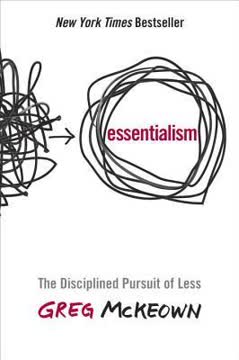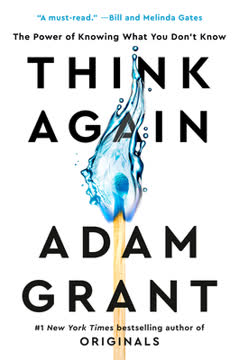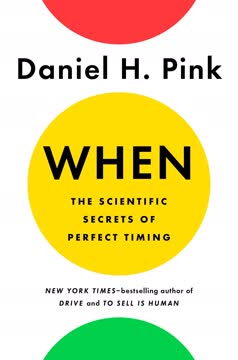Key Takeaways
1. Our daily rhythms significantly impact performance and mood
Across continents and time zones, as predictable as the ocean tides, was the same daily oscillation—a peak, a trough, and a rebound.
Peak-Trough-Rebound Pattern: Most people experience a predictable daily pattern in their mood and cognitive performance. This pattern consists of:
- Peak: Usually occurs in the morning, characterized by high alertness and analytical ability
- Trough: Typically happens in the early to mid-afternoon, marked by decreased energy and focus
- Rebound: Emerges in the late afternoon or evening, bringing improved mood and creativity
Chronotypes: People can be categorized into three main chronotypes:
- Larks: Morning people who perform best early in the day
- Owls: Evening people who peak later in the day
- Third Birds: The majority who follow the typical peak-trough-rebound pattern
Understanding your chronotype can help you optimize your schedule by aligning tasks with your natural cognitive rhythms. For example, tackle analytical work during your peak and save creative tasks for your rebound period.
2. Breaks are essential for productivity and well-being
A growing body of science makes it clear: Breaks are not a sign of sloth but a sign of strength.
Types of Breaks: Research has identified two crucial types of breaks that can enhance performance and well-being:
- Vigilance breaks: Short pauses to review instructions and guard against errors
- Restorative breaks: Longer pauses to recharge and refocus
Effective Break Strategies:
- Micro-breaks: Even brief 30-second to 5-minute breaks can boost productivity
- Nature breaks: Exposure to nature, even through a window, can improve mood and focus
- Social breaks: Interacting with others can reduce stress and increase motivation
- Movement breaks: Short walks or stretches can enhance energy and creativity
Napping: A 10-20 minute "nappuccino" (drinking coffee before a short nap) can provide significant cognitive benefits without the grogginess associated with longer naps.
3. Beginnings set the tone and have lasting effects
Beginnings stay with us far longer than we know; their effects linger to the end.
Starting Right: The way we start projects, jobs, or even days can have long-lasting impacts. For example:
- School start times: Later start times for adolescents lead to improved academic performance, reduced depression, and fewer car accidents
- Career beginnings: Entering the job market during a recession can negatively affect earnings for decades
Fresh Starts: Temporal landmarks, such as Mondays, the first of the month, or birthdays, can serve as powerful motivators for new beginnings. These "fresh start effects" can be leveraged to:
- Initiate new habits or goals
- Overcome setbacks
- Reinvigorate stalled projects
Starting Together: When individual solutions are insufficient, collective action can help overcome challenging beginnings. Examples include:
- Teaching hospitals implementing team-based approaches for new residents
- Nurse-Family Partnership programs supporting new mothers and infants
4. Midpoints can trigger slumps or spark motivation
When we reach a midpoint, sometimes we slump, but other times we jump. A mental siren alerts us that we've squandered half of our time.
The Midpoint Slump: Many people experience a dip in motivation and performance at the midpoint of projects, careers, or even life itself. This can manifest as:
- Decreased productivity in the middle of tasks
- Lower life satisfaction during middle age
- Reduced adherence to goals or standards at the midpoint of processes
The Uh-Oh Effect: Conversely, midpoints can also trigger a surge in motivation and effort. This occurs when:
- The realization of limited remaining time creates urgency
- Being slightly behind at the midpoint sparks increased effort
Strategies for Midpoints:
- Set interim goals to maintain motivation
- Use the midpoint as a trigger for reassessment and renewed focus
- Frame the situation as being slightly behind to spark motivation
- Develop mentoring programs to support those in career midpoints
5. Endings shape our perceptions and behaviors
Endings help us energize. They help us encode. They help us edit. And they help us elevate.
The Power of Endings: Conclusions have a disproportionate impact on how we remember and evaluate experiences. This manifests in several ways:
- Energize: Approaching an end often leads to increased effort and motivation
- Encode: We tend to judge entire experiences based heavily on how they conclude
- Edit: As we near endings, we become more selective about our time and relationships
- Elevate: We prefer endings that are meaningful and poignant, not just happy
Practical Applications:
- In negotiations, deadlines can lead to more agreements
- In healthcare, focusing on improving the end of procedures can enhance patient satisfaction
- In personal life, creating meaningful conclusions to experiences can increase overall satisfaction
The James Dean Effect: People often rate shorter lives that end on a high note more positively than longer lives with less remarkable endings. This highlights the importance of creating meaningful conclusions in various aspects of life.
6. Synchronizing with others enhances performance and well-being
Synchronizing makes us feel good—and feeling good helps a group's wheels turn more smoothly. Coordinating with others also makes us do good—and doing good enhances synchronization.
The Power of Synchronization: Coordinating actions with others can lead to improved performance and increased well-being. This is evident in various domains:
- Music: Choral singing boosts mood, immune function, and pain tolerance
- Sports: Synchronized movements in team sports enhance performance and satisfaction
- Work: Coordinated teams often outperform groups with less synchronization
Principles of Group Timing:
- Syncing to the boss: An external standard or leader sets the pace
- Syncing to the tribe: A sense of belonging enhances coordination
- Syncing to the heart: Emotional connection and shared purpose improve synchronization
Benefits of Synchronization:
- Increased cooperation and prosocial behavior
- Enhanced sense of belonging and social connection
- Improved physical and mental health outcomes
- Greater job satisfaction and team performance
7. Timing is a critical yet often overlooked aspect of life
I used to believe that timing was everything. Now I believe that everything is timing.
The Importance of When: While we often focus on what we do or how we do it, the timing of our actions can be equally crucial. This applies to various aspects of life:
- Work: Aligning tasks with our natural cognitive rhythms can boost productivity
- Education: Adjusting school schedules to match students' biological clocks improves learning
- Health: Timing of meals and exercise can impact their effectiveness
- Relationships: The timing of major life events (e.g., marriage) can influence outcomes
Thinking in Tenses: Our perception of time shapes our behavior and decision-making:
- Past: Nostalgia can boost mood and creativity
- Present: Mindfulness and "flow" states enhance well-being and performance
- Future: How we envision the future impacts our current choices and motivation
Practical Applications:
- Use temporal landmarks to initiate positive changes
- Align important tasks with your personal cognitive peaks
- Create meaningful endings to enhance overall satisfaction
- Leverage the power of deadlines and time constraints to boost motivation
By understanding and applying the science of timing, we can make better decisions, improve our performance, and enhance our overall well-being in both personal and professional realms.
Last updated:
FAQ
What's When: The Scientific Secrets of Perfect Timing about?
- Focus on Timing: The book explores the science behind timing and its impact on our decisions and behaviors. It presents timing as a science, not just an art, with research-backed insights.
- Three Main Parts: It is divided into three sections: The Day, Beginnings, Endings, and In Between, and Synching and Thinking, each focusing on different timing aspects.
- Practical Applications: Daniel H. Pink provides actionable advice and tools, known as the "Time Hacker's Handbook," to help readers apply insights to their lives.
Why should I read When: The Scientific Secrets of Perfect Timing?
- Research-Driven Insights: The book is based on over 700 studies, offering credible information on timing. Pink distills complex findings into engaging narratives.
- Improves Decision-Making: Understanding timing science can enhance decision-making in personal and professional contexts, from scheduling meetings to structuring your day.
- Engaging Writing Style: Pink's humor and relatability make the book enjoyable and informative, akin to a conversation with a knowledgeable friend.
What are the key takeaways of When: The Scientific Secrets of Perfect Timing?
- Daily Rhythms Matter: Our energy and focus fluctuate throughout the day, influencing when to tackle different tasks.
- Significance of Beginnings and Endings: Beginnings set the tone, while endings provide closure and motivation, crucial for personal and professional milestones.
- The Power of Midpoints: Midpoints can lead to a slump or spark in motivation, and recognizing this can help harness the "uh-oh effect."
What are the best quotes from When: The Scientific Secrets of Perfect Timing and what do they mean?
- “Time isn’t the main thing. It’s the only thing.” - Miles Davis. This underscores time's importance in our lives and decisions, impacting success and happiness.
- “Breaks are not a sign of sloth but a sign of strength.” This highlights the value of breaks for recharging, enhancing productivity and creativity.
- “If you want a happy ending, that depends, of course, on where you stop your story.” - Orson Welles. This emphasizes the significance of endings in shaping perceptions and experiences.
What is the "fresh start effect" mentioned in When?
- Temporal Landmarks: The fresh start effect refers to increased motivation at the start of new time periods, like a new year or month.
- Psychological Reset: These landmarks help individuals disconnect from past failures and approach goals with renewed vigor.
- Application in Life: It can be used strategically to set new goals or make resolutions, leveraging significant dates for motivation.
How can I apply the insights from When to my daily routine?
- Schedule Important Tasks: Prioritize challenging tasks during peak energy times, typically in the morning, for enhanced focus and productivity.
- Incorporate Breaks: Structure your day with regular breaks for rest and rejuvenation, maintaining energy levels and preventing burnout.
- Utilize Midpoints: Recognize midpoints in projects to reassess and re-energize efforts, combating motivation slumps.
What is the significance of "vigilance breaks" in When?
- Preventing Errors: Vigilance breaks are short pauses before high-stakes tasks to refocus and ensure accuracy, reducing mistakes.
- Improving Performance: Research shows these breaks enhance performance in critical situations, like medical settings, by allowing mental resets.
- Practical Implementation: Regular breaks in work routines lead to better outcomes, especially in high-pressure environments.
How does When address the concept of midpoints?
- The Slump and the Spark: Midpoints can lead to a slump or spark in motivation, and understanding this helps navigate projects effectively.
- The Uh-Oh Effect: Awareness of progress at midpoints prompts urgency, which can boost motivation and productivity.
- Strategies for Midpoints: Setting interim goals and publicly committing to them helps maintain momentum and focus.
What are the implications of chronotypes discussed in When?
- Understanding Chronotypes: Individuals have different chronotypes (larks, owls, third birds) dictating peak performance times.
- Tailoring Your Schedule: Align important tasks with natural energy peaks to enhance productivity and reduce fatigue.
- Group Dynamics: Understanding team members' chronotypes improves collaboration and performance in group settings.
How can I use the "Time Hacker's Handbook" from When?
- Actionable Tools: Each chapter concludes with practical tools and exercises for implementing insights, like scheduling techniques and break strategies.
- Personalized Application: The handbook encourages tailoring advice to specific circumstances, improving time management and productivity.
- Continuous Improvement: Regularly revisiting the handbook refines approaches to timing and decision-making, fostering growth.
What is the "James Dean effect" discussed in When?
- Definition: The James Dean effect refers to rating short, intense lives more positively than longer, less eventful ones, highlighting endings' impact.
- Implications for Life Evaluation: It suggests life quality perception is influenced by endings, not the entirety, leading to skewed evaluations.
- Connection to the Peak-End Rule: Aligns with the peak-end rule, which posits experiences are remembered by intense moments and conclusions.
How does When address the concept of "socioemotional selectivity"?
- Definition: Socioemotional selectivity is the tendency to prioritize emotionally meaningful relationships and experiences, especially with age.
- Impact on Social Networks: Awareness of time constraints leads to pruning social networks, focusing on deeper connections for satisfaction.
- Broader Applications: Applies to aging and life transitions, emphasizing meaningful connections for enhanced well-being and relationships.
Review Summary
When: The Scientific Secrets of Perfect Timing explores the impact of timing on decision-making and performance. Pink presents research on daily rhythms, optimal times for various activities, and the importance of breaks. Readers found the book engaging and practical, with useful tips for scheduling and productivity. Some criticized the lack of depth in scientific explanations and repetitiveness. Overall, reviewers appreciated Pink's accessible writing style and the book's potential to improve daily life, though some felt it wasn't as groundbreaking as his previous works.
Similar Books









Download PDF
Download EPUB
.epub digital book format is ideal for reading ebooks on phones, tablets, and e-readers.








